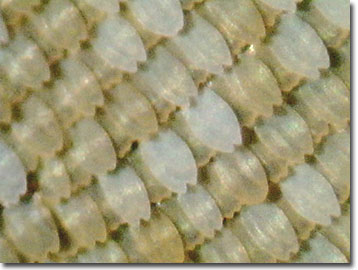Butterfly Wing Scale Digital Image Gallery
Monarch Butterfly
One of the most beloved butterflies of North America, the monarch is famous for its spectacular migrational travels. Unlike birds or migrating whales, individual butterflies only make the trip once in their lives. Amazingly, several generations later, a new group of monarchs, which are scientifically described as Danaus plexippus, make the migratory journey. The butterflies return to the same roost area and trees visited by others the previous year with only instinct to guide them.

The beauty of the butterfly takes time to develop. The female monarch lays her creamy white, spherical eggs one at a time under the leaves of milkweed. After several days, the caterpillars hatch and begin diligently feeding, ingesting and sequestering the poisonous cardiac glycosides of their sole food plant, milkweed. The caterpillars display a black and yellow warning pattern that forewarns predators of their toxicity. A few weeks later, following a significant amount of feeding and growing, the larvae pupate. The robust chrysalides are a beautiful turquoise blue with a yellow and black ring and two golden thoracic spots. Newly formed adult monarchs emerge many days later, inflating their beautiful black and orange wings before flying off to begin the lifecycle anew.
In late summer and early fall a special generation of monarch butterflies is born. They live much longer than their cohorts, sometimes up to eight months. Environmental factors cause these butterflies to delay sexual maturity and fly south toward overwintering grounds. When they reach their final destination, along the California coast or the mountains of Mexico, the butterflies cluster in large masses on tree limbs to conserve heat. On warm days, the butterflies will briefly leave their trees in search of nectar sources that they consume to replenish their energy reserves.
The overwintering monarchs do not mate until increasing temperatures and daylight hours initiate the development of their sexual organs. Since the numbers of receptive females at the winter roosts is so large and the likelihood of hybridization so small, the males do not court, nor use pheromones to lure females. Rather, they simply capture females and then mate. The male passes a nutrient rich sperm packet to the female during the process. The extra energy source helps females travel far in search of milkweed on which to lay their eggs.
By March, most of the butterflies have departed on the spring migration. Monarchs born in the spring and summer move swiftly through their life cycle, flying further north and east with each ensuing generation. Several generations pass before the shortening daylight once again reverses the direction of the migration.
Contributing Authors
Cynthia D. Kelly, Shannon H. Neaves, Laurence D. Zuckerman, and Michael W. Davidson - National High Magnetic Field Laboratory, 1800 East Paul Dirac Dr., The Florida State University, Tallahassee, Florida, 32310.
BACK TO THE BUTTERFLY WING SCALE IMAGE GALLERY
BACK TO THE DIGITAL IMAGE GALLERIES
Questions or comments? Send us an email.
© 1995-2022 by Michael W. Davidson and The Florida State University. All Rights Reserved. No images, graphics, software, scripts, or applets may be reproduced or used in any manner without permission from the copyright holders. Use of this website means you agree to all of the Legal Terms and Conditions set forth by the owners.
This website is maintained by our
Graphics & Web Programming Team
in collaboration with Optical Microscopy at the
National High Magnetic Field Laboratory.
Last Modification Friday, Nov 13, 2015 at 02:19 PM
Access Count Since January 21, 2003: 10249
Visit the website of our partner in introductory microscopy education:
|
|
